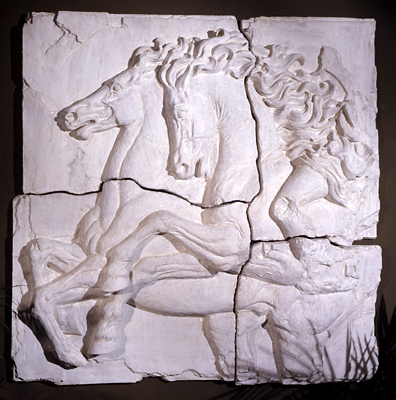
The Following Hand
"It will be therefore in respect of the capabilities of my student and those of his horse, that I shall try to put them in rapport with each other, according to the rules of balance necessary for two bodies which, the one carried by the other, have to act together." Pellier
The description brings our imagination to the image of the centaur: half man, half horse. One being with the speed, agility and grace of the horse, coupled with the logical mind of the human (oh, and thumbs too, let’s not forget the thumbs) makes for a brilliant hybrid. It’s no wonder non-horse riding cultures were shocked and awed by the sight of the first men mounted on horseback. The fusion of the two has been the subject of mythological fantasy since the Bronze Age, and continues to delight our imagination.
Of course, centaurs aren’t real…are they? In a manner of speaking, “becoming” a centaur is exactly what we attempt to do, when we mount a horse. We wish to use his four feet, his strength, stamina and agility, for our own purposes. Most of us do not ride because we enjoy “horse wrestling”, battling for domination and control by any means necessary. Many of us have affectionate feelings towards our horses, and some of us have jobs and tasks to do which requires our horse’s cooperation and agreement. When these needs and desires are combined, we realize the best and most effective way to execute is in a manner which is harmonious with the horse.
"...especially not to forget the great principle, that you cannot repeat too much, which is that in all movements, the horse and man should form one and the same body and an exactly harmonic whole... This great principle, the base of the art, must be given to any man who rides a horse, but some riders are not in position to understand it. I will respond by saying that it is necessary to find the means of making them hear this." D'Auvergne 1763
The description brings our imagination to the image of the centaur: half man, half horse. One being with the speed, agility and grace of the horse, coupled with the logical mind of the human (oh, and thumbs too, let’s not forget the thumbs) makes for a brilliant hybrid. It’s no wonder non-horse riding cultures were shocked and awed by the sight of the first men mounted on horseback. The fusion of the two has been the subject of mythological fantasy since the Bronze Age, and continues to delight our imagination.
Of course, centaurs aren’t real…are they? In a manner of speaking, “becoming” a centaur is exactly what we attempt to do, when we mount a horse. We wish to use his four feet, his strength, stamina and agility, for our own purposes. Most of us do not ride because we enjoy “horse wrestling”, battling for domination and control by any means necessary. Many of us have affectionate feelings towards our horses, and some of us have jobs and tasks to do which requires our horse’s cooperation and agreement. When these needs and desires are combined, we realize the best and most effective way to execute is in a manner which is harmonious with the horse.
"...especially not to forget the great principle, that you cannot repeat too much, which is that in all movements, the horse and man should form one and the same body and an exactly harmonic whole... This great principle, the base of the art, must be given to any man who rides a horse, but some riders are not in position to understand it. I will respond by saying that it is necessary to find the means of making them hear this." D'Auvergne 1763
1.20.12 TME
return to
Educated Equestrian
return to
Educated Equestrian

How can this be so? How is it possible for the rider to engage in rapport with the horse, which brings about his cooperation and agreement, a “harmonic whole”? The answer lies in the most clever and simple of aids; the rapport is facilitated by the snaffle bit. The educated equestrian understands the bit is the medium which allows the rider to both listen to the horse, and make requests of the horse, in polite and logical discourse. There exists a tactile language which travels between the horse’s mouth, the bit and rein,
the hand of the rider, and back again. Through the bit, the rider can feel the horse’s anxiety, tension, relaxation, attention. He can feel the footfalls, the sway of natural horse movement, and therefore make his requests in a timely and tactful manner. Listening, responding, listening, responding…it is not done through the eyes or in a vocal sense (ears and mouth) but through the sensations and responses felt between the hand and mouth. This is why the development of the following hand is crucial to the unified and harmonious efforts of the human and horse.
Control is not derived from physical power. It is not difficult to anticipate who the victor will be in a man vs. horse wrestling match. Control of the horse begins with a conversation, listening, responding, listening, responding dialogue, which allows the horse to offer his best without it being forcefully taken from him. The conversation allows, in fact encourages, the horse to make choices, and in this way, he discovers that some choices benefit him more than other choices do. It is this discovery which converts the horse to our way of thinking, our purposes and goals, so that he comes into agreement with them. An agreeable horse is light and responsive, ready to serve, and a pleasure to ride and handle.
“From science and voluntarily, my habit is that all the aids should be decreased, so that looking at them one can truly say that the horse is so kind & well trained that he acts on his own." Pluvinel
The development of a following hand, a tactful hand, is the educated equestrian’s best tool in preparing the self-managed horse.
“From science and voluntarily, my habit is that all the aids should be decreased, so that looking at them one can truly say that the horse is so kind & well trained that he acts on his own." Pluvinel
The development of a following hand, a tactful hand, is the educated equestrian’s best tool in preparing the self-managed horse.